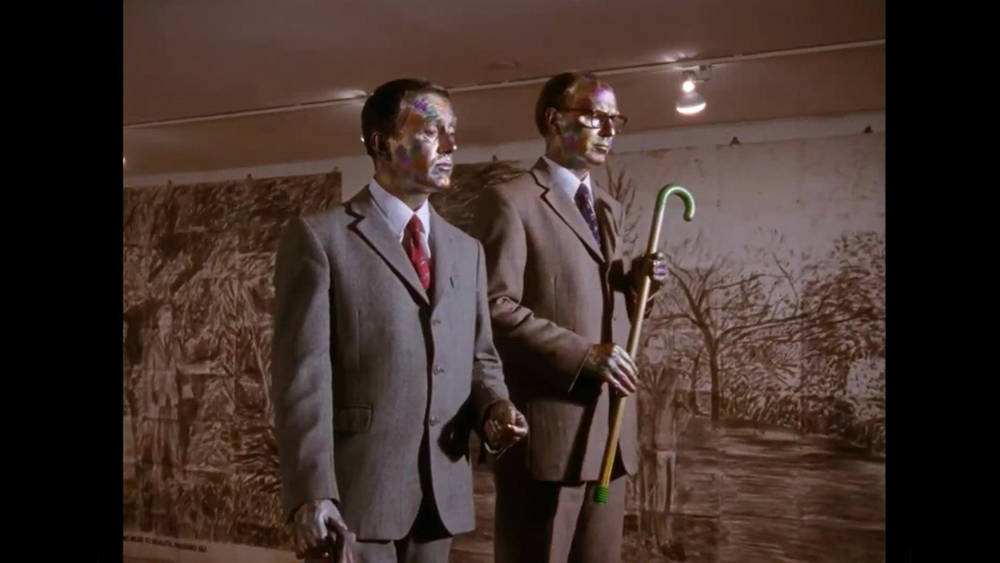When Gilbert & George first became a “Singing Sculpture” in 1969, it fell on fertile ground: In the years before, a group of artists had already radically questioned the definition of sculpture.
It was a decade that became legendary even before it came to a close: The “Swinging Sixties” transformed England and in particular its capital London from the grey, post-war period into a colorful, dazzling hub of music, fashion and art. The skirts grew shorter and color combinations and music ever more psychedelic, while the parties were pepped up with mind-expanding drugs. Like a wave arriving from the US, Pop Art crashed over the island, bringing a breath of fresh air into the institutionalized art world, and artists began to experiment with new formats.
They included Anthony Caro, who after three years working with Henry Moore had been teaching sculpture at St. Martin's School of Art in London since 1953. He encouraged his students to break with convention: Did sculptures really have to be made from bronze or stone, or might there be other materials, too? “We started to reconsider what sculpture could be,” said Caro, looking back over his life in an interview a few years before his death, and added: “I believe we broke the concept of sculpture wide open. We set it free.”
From stone to sheet metal
Previously in Great Britain, Caro said, sculpture had been a very traditional art form somewhat reminiscent of the ancient craft of stonemasonry. Inspired by the Abstract Expressionist painters he had encountered on a trip to the USA, he was keen to explore how far the concept of sculpture could be stretched and where the boundaries lay. In 1963, an exhibition at London’s Whitechapel Gallery represented the first showing of his large-format steel sculptures painted in rich colors, which caused quite a furor among students from other art schools and art critics alike – partly because Caro deliberately refrained from placing his works on plinths.
I believe we broke the concept of sculpture wide open. We set it free.

Henry Moore OM, CH, Recumbent Figure 1938, Tate © The Henry Moore Foundation. All Rights Reserved, Image via www.tate.org.uk
Under his guidance, a group subsequently developed at St. Martins College whose work later became known as “New Generation Sculpture”. Instead of working with stone and chisels, the students resorted to steel and pipes, sheet metal, plastic and synthetic materials. For the “New Generation”, art no longer had to represent status, as was the case with a painting or a bust; instead, it was to draw the observer in rather than leaving them out in the cold. The sculptors also made use of color: William Tucker, Michael Bolus and Philipp King designed sculptures in pastel colors that appear like oversized scraps of paper, while the works by David Annesley reflected the Op Art that was popular in painting at that time, with its diverse geometric forms and rich yellow, green, and blue tones.
Free of academic discourse
Yet for the next generation of artists, which included Barry Flanagan, Richard Long and Gilbert & George, this expansion of the concept of sculpture did not go far enough. “At St. Martins College of Art it was common to present one’s sculptures each month. Students then discussed the works with the lecturers as they stood before them, doing so in a language that nobody outside of the Academy could understand,” explained Gilbert & George in an interview with Hans Ulrich Obrist. They aimed to break away from the formalism which they saw as predominant and which they believed meant everybody focused solely on the external form of a sculptural work without anyone addressing its content. Where does art actually begin and where does it end? Can art breathe?

Michael Bolus, Nenuphar, 1963 © Tate, Image via www.tate.org.uk

Gilbert the Cunt and George the Shit, Magazine Sculpture, 1969, © Gilbert & George, Image via spikeartmagazine.com
Hence, they went one step further – and became a sculpture themselves. 1969 was the year they first presented their “Singing Sculpture”: Clad in their now trademark tweed suits and with their faces painted silver, they stood on a table and sang, like figures in a music box and accompanied by a cassette recorder. The tune was “Underneath the Arches” from the year 1932. It was a performance that caused the then head of the sculpture department at the art college to storm out of the room.
The sculpture was freed from its elitist existence
Gilbert & George were not to be put off, however, and over the years created not only more “Singing Sculptures”, but also “Dancing Sculptures”, “Meal Sculptures”, “Café Sculptures”, “Walking Sculptures” and “Postal Sculptures”. They had long since abandoned any dividing line between sculpture and sculptor, art and private life. The 1960s were not only the decade when Pop culture started infiltrating all areas of life; it was also the time when, thanks to Anthony Caro and “New Generation Sculpture”, fine art was freed from of its fusty, elitist existence – and thus the seed was planted for extraordinary artists such as the likes of Gilbert & George.


Gilbert & George. The Easter Cards. 1969. Postal Sculpture, The Museum of Modern Art Library, New York. Franklin Furnace Collection. © 2015 Gilbert & George, Image via www.moma.org









